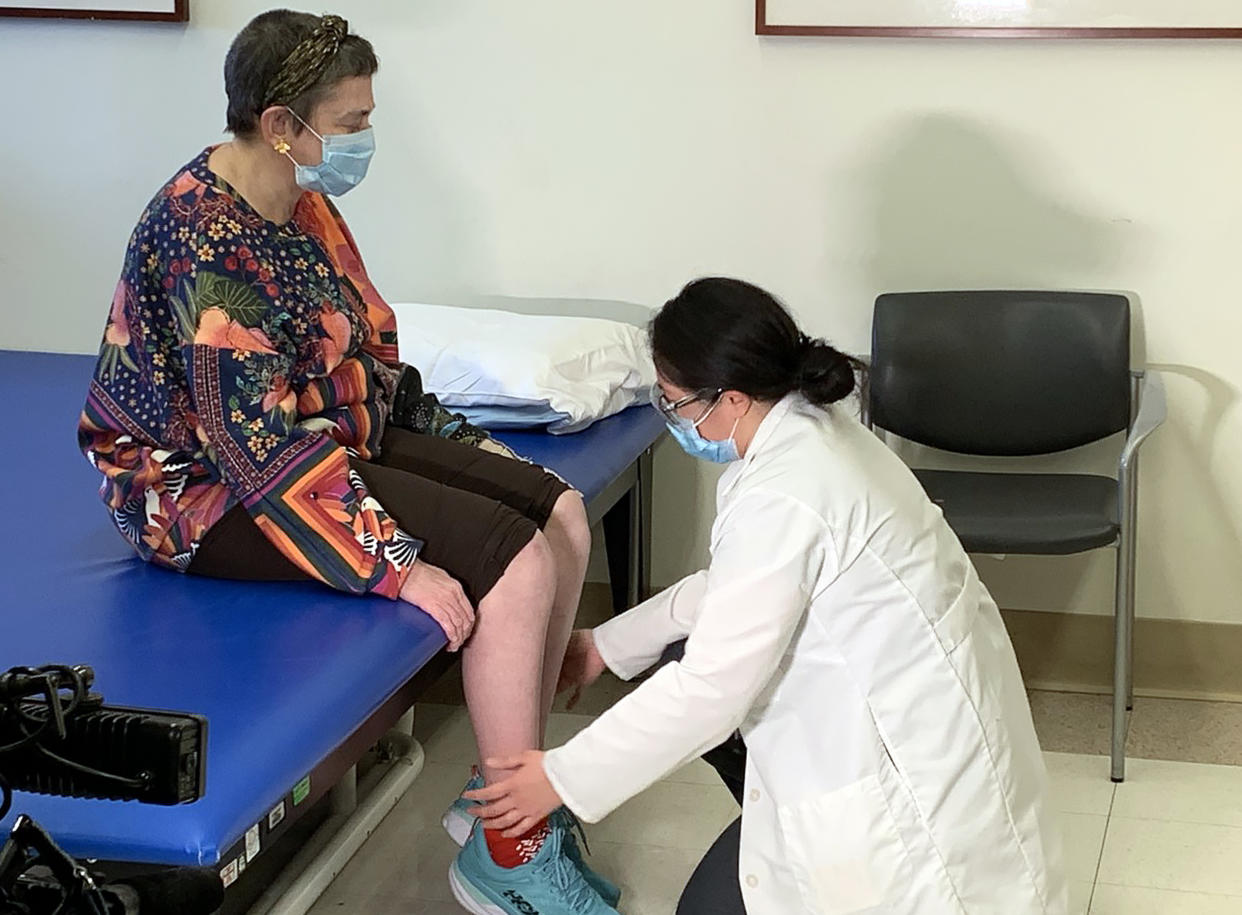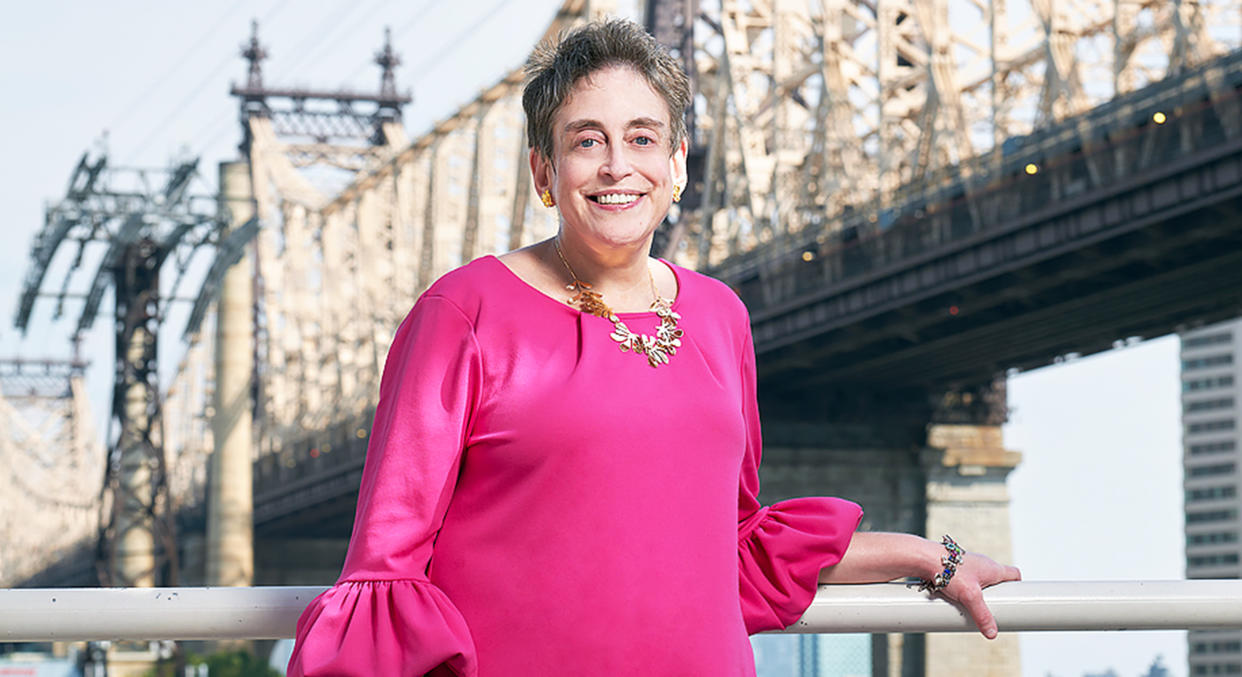Woman Details Recovery From Hammer Attack On Subway
Nina Rothschild left work late on February 24, 2022. As she walked down the stairs of the New York City subway, she felt someone hit her on the head with what she thought was a baseball bat.
“I kept saying, ‘Stop! Stop!’ which, of course, was completely useless,” Rothschild, 58, of Queens, New York, told TODAY. “I started calling, ‘Help! Help!’ and two police officers coming running from the platform below.”
The attacker — who hit her about 14 times with a hammer — took her purse. It had her credit cards, phone, insurance card and even some jewelry in it. The police called an ambulance, which rushed her to NewYork-Presbyterian/Weill Cornell Medical Center where doctors reconstructed her shattered skull.
“As I like to say, they put Humpty Dumpty back together again,” Rothschild said.
Attack and skull surgery
Rothschild never saw the attacker and didn’t even learn he wielded a hammer until later. She believes she was conscious throughout the attack.
“When I was still on the subway steps where I’d been assaulted, I touched my head with the back of my hand and became upset,” she said. “I don’t remember any pain at all.
When the ambulance arrived at the scene, she asked them to take her NewYork-Presbyterian/Weill Cornell Medical Center. Her primary care doctor was there, so she knew they’d accept her insurance. As help arrived, Rothschild began to calm.
“They put the oxygen mask over my nose I just felt a sense of relief,” she said. "This was the beginning of a healing recovery."
When Rothschild arrived at the hospital, she underwent an MRI so doctors could better understand her injuries and staff prepared for surgery. Doctors then removed the dirt and debris in the wounds in order to repair her skull.

“She was quite good actually when I first met her,” Dr. Justin Schwarz, a neurosurgeon at NewYork-Presbyterian/Weill Cornell Medical Center, told TODAY. “But she had quite a few complex lacerations right down to her bone and obviously the impact of the hammer had caused her fracture her bone right in the top of her head in multiple locations to the point where they were quite depressed.” Schwarz felt stunned by how “calm” Rothschild was when she arrived. He and his colleagues performed a craniotomy on her to reconstruct her damaged skull.
“What we did is one, removed the pulverized bone. There’s actually a lot of dirt and gravel embedded into the fractured bone in two places in particular,” he said. “We removed really the piece of bone right where the bone was most injured.”
The medical team washed out the areas with an antibiotic solution to reduce the likelihood of infection. Then they needed to put skull back together. Unfortunately, the hammer had damaged some parts of her skull beyond repair.
“In her situation, two pieces of titanium mesh (were needed) to really reconstruct the bone and the contour of the bone and then really primarily repair all of the lacerations that she had the best we could,” Schwarz said.
While Rothschild experienced “some bruising of her brain right under where she had the hardest blow,” she experienced very little injury to her brain. She has foot drop — an inability to lift the front of the foot because of muscle weakness or paralysis — caused by the attack and some “post-concussive” like symptoms. She also sustained a fracture of her left hand, and she experienced benign paroxysmal positional vertigo, which made her feel as if she was spinning, at times.
For several days, Rothschild stayed in the neurological intensive care before moving to a step-down unit. Almost immediately, she started physical therapy, even though her foot drop made walking challenging.
“These two physical therapists were trying to encourage me to walk a little bit. I could barely sort of lurch practically wrapped around them from my bed into the hallway,” she said. “That was sort of staggering and lurching and not being very successful.”
But she kept trying. The support from hospital staff, including nurses, doctors, physical and occupation therapists, as well as friends and family helped her as she recovered.
“People were just so wonderful,” Rothschild said. “It was really morale boosting.”
Still, some of recovery was a learning experience.
“One of the nurses said, ‘Would you like to take a shower?’ and, of course, I was thrilled,” Rothschild recalled. “To be assisted in the showering process was not something that had ever happened to be as an adult. So, it is quite a change of mindset because I definitely pride myself on being pretty independent … all of a sudden you need assistance with some of the basic activities of daily living. It’s a bit of a shock.”
After two weeks of in-patient rehabilitation, Rothschild started outpatient physical, occupational and hand therapy.
“I needed to learn how to walk again. I had foot drop,” she said. “I wasn’t able to use that foot for anything."
After weeks of physical therapy, though, Rothschild had a breakthrough.
“I started to move my toes. There had been very, very, very minimal ability to do anything and all of a sudden I was gaining strength,” she said. “I was thrilled.”

Riding the subway again
In July, Rothschild finished hand therapy. By early September, she finished physical therapy. She recently returned from a vacation to Sicily and is back to working full time at the New York City Department of Health and Mental Hygiene. And she still rides the subway.
“I’m raring to go and really it’s almost as if there are no traces left of what happened. Although I am reminded of it every day when I can’t move my head because my skull feels a little different,” she said. “I am more concerned when I go up and down subway steps than I was in the past. I often look behind me.”
While the attack felt scary and required a lot of recovery, Rothschild hopes it doesn’t cause people to think of New York or the subway as dangerous.
“I’m afraid that for some of them it might just confirm their fears of New York because there was a whole rash of incidents for a while, the most horrifying being when that woman was pushed off a subway platform,” she said. “You should be aware and alert at all times.”
Rothschild doesn’t feel like she’s experiencing any heightened anxiety or post-traumatic stress disorder from her attack. In fact, her experience reaffirmed how much she enjoys life.
“I really love life,” she said. “I want to live every minute to the fullest.”
This article was originally published on TODAY.com
